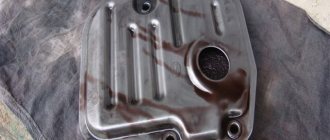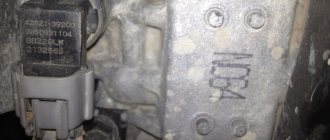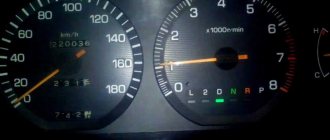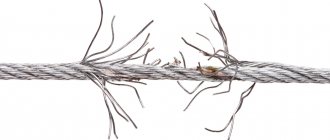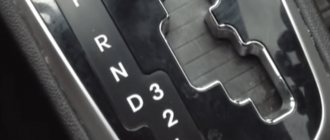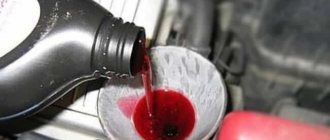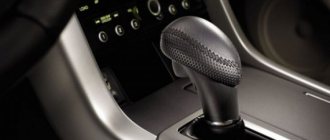- Torque converter malfunction
Transmission slipping (automatic transmission slipping) is one of the most serious problems that a car owner can face. Let's talk about the main signs of automatic transmission slipping and understand the reasons why the automatic transmission slips.
A large number of modern cars are equipped with an automatic transmission, as more and more drivers prefer it in order to have less worries. There are a lot of reasons why a manual shifts poorly, but in this article we'll talk about a number of problems that arise with an automatic, including, most notably, lower efficiency and slippage.
The vehicle's transmission ensures transmission of the torque created by the engine, allowing the engine's power to be used as efficiently as possible. Thanks to the transmission, it becomes possible to change gears. An automatic transmission makes driving easier by automatically changing gears according to the vehicle's speed. There is no clutch pedal, so the driver only cares about steering, acceleration and braking. Although this transmission has its own problems, and one of them is that the automatic transmission gears slip.
How to avoid problems
First of all, it is worth understanding that any malfunction of the transmission can be caused by physical wear and tear of the unit, or be the result of improper operation of the vehicle. Most drivers forget that they need to change the automatic transmission oil on time. This leads to problems with the lubricating fluid, which ultimately causes the device to overheat.
As a result, the moving elements of the box quickly fail and require either complete replacement or expensive repairs.
It is quite easy to prevent automatic transmission malfunctions - it is simply important to properly care for the vehicle and not violate its operating conditions. Simply warming up the car before driving in frosty weather, using high-quality oil, and avoiding aggressive driving will help you avoid many breakdowns.
The difficulty in troubleshooting automatic transmissions is that many problems can be diagnosed and corrected only by completely disassembling the unit. It is almost impossible to do this at home. Therefore, you will have to go to a service station and pay considerable sums for diagnostics.
The car service technicians themselves willingly share their diagnostic methods.
Determining a breakdown by ear. As a rule, the motorist himself notices that the automatic transmission has begun to sound somehow different. Most often, if the device “sounds” incorrectly, a routine oil change and filter cleaning are required. Determination of breakdown at the tactile level. Sometimes a simple electrical circuit check can help. If the malfunction is more serious, the specialist removes the pan. All these manipulations relate to inexpensive diagnostics. Today, without dismantling, you can carry out many tests: this is a table test, and reading fault codes and checking the pressure on the line. All these actions are accompanied by topping up or completely replacing the transmission oil. "Parsing". Such extreme measures are necessary if the other two have not helped.
If the emergency mode of the unit is visible, then it is important to disassemble the transmission into all parts. In most cases, such disassembly is needed for cars whose mileage exceeds 200,000 km.
Stages of diagnosis
Automatic transmission diagnostics can be divided into the following stages:
- The stage of establishing visible and, most importantly, audible problems. This is the first and fastest type of diagnosis of automatic transmission faults, which the car owner himself can do and, based on assumptions about problems, contact a specialist.
- Stage of medium level of complexity, so-called tangible. This diagnosis can only be carried out by a specialist, since it directly involves reading codes, various autotests, and then establishing a “diagnosis”.
- The repair stage, which is resorted to after the first two stages. It begins after slipping has been diagnosed and can ONLY be carried out by a highly qualified automatic transmission repair technician. Otherwise, you can completely ruin your car and significantly increase the possible costs of repairing it. This stage is most often necessary when the car is already in poor condition (driving in 3rd gear) or when the clutches are slipping. In all of the above cases, disassembling the automatic transmission is necessary. Only this procedure will help you determine with 100% accuracy both the type of breakdown and the method of repairing it.
How to understand that the automatic transmission is slipping
Slipping of an automatic transmission is a serious malfunction, so the degree of manifestation varies: from the absence of defects to the transformation of the car into a piece of metal
Often the symptoms indicate another breakdown and you need to figure out what to look for. The fact that the automatic transmission is slipping is manifested by the following situations:
- Engine speed increases - an unreasonable increase in speed to 3-3.5 thousand revolutions leads to the gearbox switching to overdrive mode.
- Coasting motion - inertia does not allow the car to stop instantly, even if the gas pedal is not pressed. When the transmission slips, the car coasts longer than it would if it were in full working order.
- Slow downshifting - if, when the engine speed is lowered, the automatic transmission “thinks” for a long time before engaging a lower gear - this is a sign of a slipping transmission. Switching also occurs with increasing speed, when the engine idles for several seconds and the gearbox simply does not have time to pick up the speed.
- Acceleration lags—if the revs rise but the car takes a few seconds to accelerate—this is a major sign of gear slippage.
- Red transmission fluid is an ambiguous sign, but if it is present, it can be considered that the automatic transmission is slipping.
- Strong sounds at speed - an extraneous grinding noise that intensifies during acceleration and braking, can also indicate slipping of the automatic transmission gears.
- Problems with reverse gear - shifting gears in cold weather with a delay is the main sign that the automatic transmission is actually slipping. In this case, switching is carried out with a delay, without the smoothness of the “automatic”.
Based on the above-described series of signs, you can diagnose the situation that the automatic transmission is slipping. Having learned about the diagnosis, you should understand its reasons, which cannot be ignored.
What to do if your automatic transmission is low on fluid
Next question: why? Probably because you have a leak. You may have noticed red transmission fluid in your driveway or in a parking space at work, but it didn't occur to you that it was leaking from your car. The cause of your leak is likely a failure in one of the seals that keep the oil inside the transmission (although there are other places where the transmission can leak). How many seals the transmission has depends on whether you have a front-wheel drive, all-wheel drive, or rear-wheel drive vehicle.
If you have a leak and you catch it in time before it damages your transmission, chances are it could be relatively cheap to fix. The seals themselves are not expensive parts, but depending on where they are located, they can require a lot of labor to replace.
How can you tell if your car is slipping?
If you begin to notice that your car, while in motion, seems to be slipping part of the road or you hear that the engine of your car has begun to idle when shifting to a higher gear, then you are faced with slipping. One of the main reasons for slipping when shifting to a higher gear is considered to be the use of low-quality transmission oil for your car. If the reason that your car is slipping when switching is low-quality oil, then the solution to the problem will be to replace parts such as the air filter and directly change the oil itself. But you should remember that such a simple solution can only help with slight slippage when switching. In all other cases, a rather long and labor-intensive repair of your automatic transmission will be inevitable. If the car slips only when switching to cold, then you should check the clutches.
Also, if your car slips when cold, you need to check the oil level. If the oil is below normal, then you have found the cause of the problem, as well as its solution. If you fill up the oil, but the car still slips when cold, then it is likely that it is time to replace the clutch.
But in order to be completely sure that cold slippage appeared precisely for this reason, you need to contact a qualified specialist with extensive experience in solving such issues.
It can also happen that when switching to cold the car behaves normally, but when switching to hot it slips. In this case, everything is much more serious and an independent decision, or rather, attempts at this solution can cost you quite a large sum. To properly eliminate the problem of a car slipping from an automatic transmission to a hot one, you must immediately contact a good, proven service center.
Also, one of the most common problems is the car slipping when changing gears. Most often, this indicates a malfunction of the valve body. However, this theory can be verified for accuracy only through computer diagnostics of the car, and therefore an independent solution to this problem is impossible.
If your car slips when starting from a stop, then most likely your air filter is clogged. This is a fairly typical and quite easily fixable problem.
Moreover, slipping when starting is one of the few automatic transmission problems that you can replace yourself with minimal knowledge in the field of car repair. To eliminate this problem, it is enough to replace (replace, not clean) the air filter.
Automatic transmission diagnostics
The initial diagnosis is precisely to identify symptoms indicating transmission slippage. As a rule, you can determine that an automatic transmission is slipping on your own based on the appearance of various noises and unusual behavior of the car when changing gears. Based on the detected symptoms, you should contact a specialist, since independently clarifying the diagnosis will require disassembling the box. If with a manual transmission this is quite acceptable even in a garage, then with an automatic transmission it is not.
The simplest and most accurate way to identify problems is computer diagnostics, which allows you to localize the problem in a matter of minutes based on the received error codes.
In the vast majority of cases, repairs will still require dismantling the automatic transmission, and it is at this stage that the preliminary diagnosis obtained on the basis of computer diagnostics is usually confirmed or refuted. Of course, this work must be performed by qualified specialists. Without the appropriate experience and skills, attempts at self-recovery are doomed to failure in 99% of cases. So clutch slipping is by no means an insignificant problem.
Signs of automatic transmission slipping
The automatic transmission may not slip from day to day. At first, when the problem begins to develop, slipping of the automatic transmission is observed several times a day, repeating after three or four days.
The first signs begin with slow acceleration with the gas pedal pressed to the floor. The first step is to check the lubricant level. If it is not enough to the required level, then top it up. Fill only with high-quality and original oil.
If the slipping does not go away, then it is recommended to go to a service center to troubleshoot the automatic transmission.
A sharp increase in engine speed
The automatic transmission slips and increases engine speed, but the vehicle does not accelerate. This is the first sign of a box malfunction. For example, if the speed rises to 4000 rpm, the automatic transmission switches to Over Drive mode.
This indicates that the lubricating fluid has become unusable, or low-quality oil was poured, or the level is below the required level. The lubricant has lost its properties, does not reduce friction, as a result, gears do not shift, and the speed does not increase.
Long-term coasting
Automatic transmission malfunctions appear when the car continues to move when it should have stopped. For example, when a car owner takes his foot off the gas pedal, and the car continues to roll for some time.
Hot
When the automatic transmission slips when hot, the problem may lie in faulty solenoids. Symptoms: the driver cannot change gear, the speed may increase, but the speed, on the contrary, may drop.
The automatic transmission slips while driving when the solenoids fail. In order not to aggravate the situation, experts recommend immediately contacting service.
In the cold
When the automatic transmission is cold, it slips when starting. The tachometer will show high rpm, but the car will not be able to move, or it may start moving, but the speed will not increase. You can press the gas pedal all the way to the floor, but this will not increase the speed, although the car will roar and rush forward like a beast.
Slow downshifts
If the reverse gear of the automatic transmission is slipping, or slow downshifting is observed, this is also one of the symptoms of a malfunction of the automatic transmission. The driver feels it like a push.
Read
What is the difference and how does a robotic gearbox differ from an automatic gearbox?
When switching
When the automatic transmission slips when changing gears, there may be a malfunction in the electronic control unit. Errors in software, aging electronic brains all lead to the fact that the box will work intermittently.
The driver feels shifting failures as a push or jerk when changing from one gear to another. The car starts to jerk, sometimes it comes to a stop, and then starts moving. The latter occurs when the automatic transmission disease is completely advanced.
Sounds at high speeds
The driver hears dull knocks at high speeds - this means that the torque converter is faulty. If they appear intermittently, the machine may last for some time without repair. If it happens regularly, this will mean that the oil pump gears are worn out.
Often the sounds are accompanied by a hum, rattling of the entire box, and the automatic transmission slips. In this case, a check at the service center is required.
Problems engaging reverse gear
Problems with engaging reverse gear may also be due to the fact that there is a malfunction in the box. This problem especially manifests itself in the cold season.
Switching occurs with a slight stop, the box slips. The driver does not observe a smooth ride. Sometimes we will feel a push or a jerk.
Let's sum it up
If slipping, jolting or jerking in the automatic transmission begins to appear when the car is moving, you need to contact a service station for high-quality and accurate diagnostics.
In the first case, the nature of the breakdown is determined based on the readings of diagnostic instruments; it is often possible to normalize the operation of the box by simply changing the automatic transmission oil and filter.
Accordingly, the cost of the repairs performed will depend on the specific breakdown of the automatic transmission and the total scope of work. It is important to remember that even a simple change of oil and oil filter in a machine is a rather labor-intensive and costly procedure. For this reason, you need to clarify in advance how much it costs to change the oil in an automatic transmission.
Finally, we note that proper operation of a vehicle with an automatic transmission and its timely maintenance will extend the service life of the unit, which eliminates premature and expensive repairs of the vehicle’s automatic transmission.
Checking the oil level in an automatic transmission: how to check the ATF level. What else to pay attention to: color, smell, ATP contamination, etc.
Automatic transmission solenoid: design of solenoids, operating principle. Frequent malfunctions and breakdowns of solenoid valves, diagnostics, repair and replacement.
Why the automatic transmission kicks, the automatic transmission jerks when changing gears, jerks, jerks and impacts occur in the automatic transmission: the main reasons.
Is it possible to tow a car with an automatic transmission: basic rules and recommendations. What you need to consider if a car with an automatic transmission is towing another car.
How to service an automatic transmission: changing the automatic transmission oil and oil filter, the cost of changing the oil in an automatic transmission. Methods for replacing ATF, recommendations.
Automatic transmission valve plate (valve unit): design of the valve body, purpose, principle of operation. Valve unit malfunctions, causes of breakdowns, diagnostics and repair.
Slipping when shifting automatic transmission gears: why does the automatic transmission slip?
Let's start with the fact that the automatic transmission consists of three main parts, each of which performs certain functions.
- Torque converter. The torque generated by the engine is increased by the torque converter and then transferred to the planetary gearbox using oil flows and pressure.
- The planetary gearbox changes the amount of torque received from the torque converter and the output number of the gearbox in accordance with the driving modes. This happens by blocking some gears and unlocking others. A set of clutches and brake mechanisms responsible for switching between gears block and stop the elements of the planetary gear.
- Hydraulic control system. It is designed to control a planetary gearbox.
As mentioned above, transmission breakdowns often manifest themselves as noticeable jolts when changing gears. The automatic transmission may also slip at different stages. At the same time, the difficulty of diagnosing an automatic transmission malfunction often lies in the necessary complete dismantling of the entire unit.
Signs of automatic transmission slipping
Slipping of the automatic transmission is manifested by slight slipping when the accelerator pedal is sharply pressed or when shifting to a higher gear. With such slippage, traction is lost and the car engine begins to idle.
If you continue to operate the automatic transmission without paying attention to this malfunction, then in the future the slipping will increase significantly, the box will begin to slip even when starting from a standstill, as well as when the automatic transmission is switched to both a lower and higher gear.
Why the automatic transmission slips: reasons
Slipping when shifting an automatic transmission to a higher gear often indicates the use of low-quality gear oil or one that has lost its properties. Also in this case, it is recommended to check the oil level. The oil should not be below or above the required mark.
If slipping occurs only when the automatic transmission is switched “to cold,” then it is necessary to check the clutches (friction discs). Friction discs are installed on the planetary gearbox. When the gear is off, the rotation of the friction rings relative to each other is completely free.
When the gears are engaged, the friction rings, pressing against each other, allow the planetary gearbox (sun gears in a certain order) to be rotated. At the same time, clutches are short-lived and wear out over time (with a vehicle mileage of 200-250 thousand kilometers).
Hydroblock. Clogged valve body channels do not allow for a high-quality supply of ATF to the moving elements. The hydraulic unit channels are cleaned using cleaning chemicals under the influence of ultrasound.
This work is carried out only on the removed valve body and is very labor-intensive. Also, after repairing the valve body, it is recommended to replace all filters of the car and, accordingly, the transmission oil in the automatic transmission.
If the oil change is completed, but slipping occurs when the automatic transmission is switched “to hot,” this means that the solenoid block and/or pump has failed. As a result of using low-quality or used oil, solenoids become unusable.
To identify this malfunction, the pressure in the lubrication system is measured. If the pressure in the system is at a low level, then the problem lies in the solenoids or in the pump.
Another possible reason for the automatic transmission slipping may be a failure in the electronic control unit (automatic transmission ECU). The ECU is a complex electronic device for an automatic transmission. The control system consists of a memory in which automatic transmission control programs are stored.
The unit also interacts with groups of sensors that provide information at each specific moment in time about the state of the controlled area during the operation of the automatic transmission itself, actuators, etc.
To accurately check the automatic transmission ECU and determine the problem, you must contact a service center to carry out high-quality and accurate diagnostics. If a defect is detected, the problem is often solved only by completely replacing the automatic transmission electronic control unit, since the device is often beyond repair.
Automatic transmission slipping due to burnt clutches
In order to completely get rid of automatic transmission slipping, many service companies conduct thorough diagnostics of friction connections. The basis for concern is the reduced durability of the friction linings of the clutch discs. During the operation of the vehicle, soft friction discs wear out most quickly, become unusable and cease to perform their functions.
As a rule, disc wear occurs after a mileage of 250–300,000 km. After the car has passed this route, it is necessary to completely change the automatic transmission clutches. The procedure for replacing friction elements is a complex, time-consuming undertaking. It is not recommended to carry out such work at home.
Attention: Prolonged operation of a vehicle with burnt clutches will lead to increased automatic transmission slippage and further expensive overhaul of the gearbox and power unit.
Untimely replacement of ATF transmission oil in an automatic transmission entails prolonged towing of the automatic transmission followed by expensive repairs. Premature wear of friction linings causes great harm to transmission oil, filter elements, and has an adverse effect on the general technical condition of the automatic transmission and transmission as a whole.
The friction discs included in the kit are part of the clutch mechanism for the working gears of each gear. If slipping is noticed when the selector is switched to any gear (for example, automatic transmission slipping from 2 to 3), you can understand where the friction clutch is damaged.
Automatic transmission ECU
If eliminating all of the above reasons does not solve the problem, the only thing left to blame is malfunctions in the operation of the control electronic unit. Incorrect functioning of the transmission ECU, it turns out, can also affect the operation of individual elements of the gearbox. What to do if the automatic transmission is slipping precisely because of a faulty electronic unit? There are cases when the problem was fixed by flashing it, but most often the ECU has to be replaced with a new unit. It is not difficult to diagnose such a malfunction using an on-board computer, but both diagnosing and replacing the ECU is a procedure that requires the appropriate knowledge and equipment, so you cannot do it yourself. Be prepared for the fact that the cost of this operation specifically for your automatic transmission will not coincide with the market average. This is quite acceptable, since it depends on the design of the box, and it is different for all major manufacturers.
As you can see, independent repair of an automatic transmission is not recommended, even if at first glance it seems that no difficulties should arise. If manual transmissions are designed in principle the same, the differences are mainly only in geometry, then with automatic transmissions the situation is completely different. The slightest mistake during installation - and the chance of permanently damaging the automatic transmission will rapidly increase, and this is one of the most expensive (after the engine) components of a modern car.
Gas turbine repair or replacement?
Thank God there are enough options for solving the problem. You can replace the bagel, buy a new or restored one, or order the restoration of your own. The main thing here is not to get carried away, but to make calculations. Your task is to find an automatic transmission repair service, clarify the cost of repairs and find out what suits you best: completely replacing the donut, repairing it, or buying a used gas turbine engine.
I don’t recommend trying to do this kind of work at home; without the proper tools and experience, you’re unlikely to succeed; it’s not like changing spark plugs or silent blocks in levers.
Automatic transmission malfunctions
All automatic transmission malfunctions can be divided into:
- problems in electronics;
- problems in hydraulic and mechanical systems.
So, in an electrical system, a controller may fail, short circuits may occur, control system sensors may break, and actuators may refuse to work.
Electronic failures are quite easy to recognize - the sensors instantly signal to the driver that the automatic transmission “does not get along” with the electrics. Moreover, emergency work programs are launched that maintain the functioning of the gearbox.
Malfunctions of hydraulic and mechanical systems are much broader:
- wear of clutch discs, brake bands;
- problems in the operation of the torque converter;
- malfunction of the oil pump, clogged channels;
- wear of shafts and gears;
- hydraulic unit failure.
Repair cost
The cost of repairs for a slipping transmission depends on the specific breakdown. In some cases, this problem can be eliminated by replacing the transmission oil and filter elements. In this case, the cost of work with spare parts will not exceed 5,000-10,000 rubles. At the same time, if there are problems with the valve body, clutches or control unit, the cost of repairs can amount to several tens of thousands of rubles. Remember that the exact cause of a breakdown can only be determined by carrying out the most detailed diagnostics. It is after such a diagnosis that an experienced specialist will tell you the amount of repairs and only after that will begin to fix the breakdown.
When planning repair work on the gearbox, it is necessary to remember that the automatic transmission is a complex structural element, the quality of which can only be serviced and repaired by experienced specialists. That is why we do not recommend that you skimp on the quality of repairs and trust garage specialists to fix problems. Only by contacting specialized service centers, you will be able to completely eliminate existing problems in the operation of gearboxes and receive a guarantee for the repairs performed.
The automatic transmission is slipping: reasons for the automatic transmission slipping
An automatic transmission is a complex mechanism. The automatic transmission transmits torque from the engine to the drive wheels, and automatically selects the desired gear.
Also, during operation, the owner may encounter that the automatic transmission is slipping, gears are not engaged in a timely manner, jerks, bumps, shocks of the automatic transmission, etc. occur when switching. Next, we will talk about why the automatic transmission slips, as well as how to fix this problem.
Slipping when shifting automatic transmission gears: why does the automatic transmission slip?
Let's start with the fact that the automatic transmission consists of three main parts, each of which performs certain functions.
- Torque converter. The torque generated by the engine is increased by the torque converter and then transferred to the planetary gearbox using oil flows and pressure.
- The planetary gearbox changes the amount of torque received from the torque converter and the output number of the gearbox in accordance with the driving modes. This happens by blocking some gears and unlocking others. A set of clutches and brake mechanisms responsible for switching between gears block and stop the elements of the planetary gear.
- Hydraulic control system. It is designed to control a planetary gearbox.
Normally, an automatic transmission ensures ease of driving a car with automatic transmission and maximum comfort. However, during operation, an automatic transmission, like any other vehicle mechanism, can fail.
As mentioned above, transmission breakdowns often manifest themselves as noticeable jolts when changing gears. The automatic transmission may also slip at different stages. At the same time, the difficulty of diagnosing an automatic transmission malfunction often lies in the necessary complete dismantling of the entire unit.
Signs of automatic transmission slipping
Slipping of the automatic transmission is manifested by slight slipping when the accelerator pedal is sharply pressed or when shifting to a higher gear. With such slippage, traction is lost and the car engine begins to idle.
If you continue to operate the automatic transmission without paying attention to this malfunction, then in the future the slipping will increase significantly, the box will begin to slip even when starting from a standstill, as well as when the automatic transmission is switched to both a lower and higher gear.
Operating an automatic gearbox in winter
The largest number of automatic transmission breakdowns, including the occurrence of slipping, occur in the cold months of the year. The reasons for this phenomenon lie in two operational features.
- The first is lower air temperature.
- The second is wheel slipping on ice at the start.
Many drivers sincerely believe that preparing a car for the cold season consists only of replacing summer tires with winter ones.
They do not take into account that the automatic transmission also needs to be adapted for operation in cold weather.
The main point that you should pay attention to when operating a car with an automatic transmission in cold weather is the fluid poured into the hydraulic system of the box. During prolonged use under conditions of air temperature changes, the liquid very suddenly loses its characteristics and thickens, which leads to oxidation.
Already at an air temperature of minus 7 degrees, the fluid in the hydraulics begins to cool and thicken. When the car warms up, heat does not enter the gearbox, which is why when starting off and in the first minutes of driving, the gearbox operates in a state of oil starvation, as well as with reduced pressure. It is because of this that the friction clutches burn out, and as a result, the box slips.
Slipping can also occur due to freezing of the hydraulic system filter in cold weather. In the winter months, you shouldn’t wait until the last minute to reach the required 30 thousand kilometers; it’s better to replace the filters in advance. Replacing the filter element and updating the hydraulic fluid can eliminate many of the reasons why the automatic transmission slips.
For those who don't know, while the engine is warming up, you can also partially warm up the automatic transmission. To do this, you just need to depress the brake pedal and move the gearbox lever to the “L” or “R” position.
The influence of the electronic control unit (ECU) on automatic transmission slippage
Incorrect functioning of the automatic transmission control unit is also the cause of machine slipping. The problems lie in the failure of ECU elements. Most often, a decision is made to completely replace the entire automatic transmission control unit.
Despite the fact that diagnosing this problem is not very difficult, it is not always possible to carry it out at home. It is best to contact a specialized center equipped with special diagnostic devices. The cost of services for identifying and troubleshooting the electronic control unit differs; it depends on the price of a car with an automatic transmission.
Source
Why does the automatic transmission slip and how to fix it
Unfortunately, the availability of all kinds of information on the Internet about various breakdowns, including automatic transmission faults, will not help you fix the breakdown yourself. That is why it is strongly recommended not to resort to “self-medication”, because the machine, like the human body, needs, first of all, high-quality professional help.
It is also not recommended to ask questions regarding the diagnosis of automatic transmission faults on the Internet or by phone; as soon as slipping has been detected, you must immediately contact a good service with highly qualified auto repair specialists.
One of the main reasons for the impossibility of independently “treating” an automatic transmission is that in order to determine the breakdown, it is necessary to carry out computer diagnostics of the automatic transmission and only after that prescribe “treatment”. Only a master can carry out a truly high-quality assessment of the condition of your car and begin subsequent repairs.
